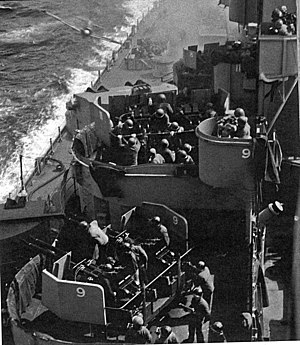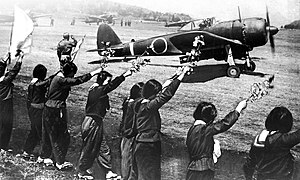Japanese Special Attack Units



This article needs additional citations for verification. (October 2009) |
You can help expand this article with text translated from the corresponding article in Japanese. (February 2018) Click [show] for important translation instructions.
|
During
Background
Towards the end of the
Japan saw the efficacy of the specialized units during their deployment in the Philippines in summer-fall 1944 when special attack units executed their first missions.[1] Japan saw that they were able to achieve results with limited resources.[3] Historians view the success of the suicide tactics as an important driver to Japanese war policies after 1943.
Aircraft
Ohka suicide rocket aircraft

The
It was a small flying bomb that was carried underneath a Mitsubishi G4M2e "Betty", Yokosuka P1Y Ginga "Frances" (guided Type 22) or planned Heavy Nakajima G8N Renzan "Rita" (transport type 33) bomber to within range of its target; on release, the pilot would first glide towards the target and when close enough he would fire the Ohka's engine(s) and dive onto the ship to destroy it. That final approach was almost unstoppable (especially for Type 11) because the aircraft gained tremendous speed. Later versions were designed to be launched from coastal air bases and caves, and even from submarines equipped with aircraft catapults, although none were actually used this way.
Shinryū
The Mizuno Shinryū (神龍, "Divine Dragon") was a proposed rocket-powered kamikaze aircraft designed for the Imperial Japanese Navy towards the end of World War II. It never reached production.
Tsurugi
The
Baika
The
Boats

Shin'yō and Maru-Ni
The
Around 6,200 Shin'yō were produced for the
Submarines
Kaiten

The
Early designs allowed for the pilot to escape after the final acceleration towards the target, although whether this could have been done successfully is doubtful. There is no record of any pilot attempting to escape or intending to do so, and this provision was dropped from later production kaitens. The inventor of the Kaiten, Lt. Hiroshi Kuroki was lost during one of the first training missions. When the sub was raised, a note written during his final minutes before death was found, sending his respects to his family and detailing the cause of the accident and how to repair the defect.
Kairyū

The , designed in 1943–1944, and produced from the beginning of 1945. These submarines were designed to meet the invading American Naval forces upon their anticipated approach of Tokyo.
These submarines had a two-man crew and were armed with two torpedoes and an internal warhead for suicide missions. Over 760 of these submarines were planned, and by August 1945, 200 had been manufactured, most of them at the Yokosuka shipyard.
Divers
Suicide divers (伏龍, Fukuryū, "Crouching dragons") were a part of the Special Attack Units prepared to resist the invasion of the Home islands by Allied forces. They were armed with a mine containing 15 kg (33 lb) of explosive, fitted to a 5 m (16 ft) bamboo pole. They would dive and stick the pole into the hull of an enemy ship, destroying themselves in the process. They were equipped with a diving jacket and trousers, diving shoes, and a diving helmet fixed by four bolts. They were typically weighed down with 9 kg (20 lb) of lead, and had two bottles of compressed air at 150 bars. They were expected to be able to walk at a depth of 5 to 7 m (16 to 23 ft), for about six hours. Several deaths occurred during training due to malfunctions, but this weapon is only known to have been used a few times operationally:
- January 8, 1945: Damage by suicide divers to Infantry landing craft (gunboat) LCI(G)-404 in Yoo Passage, Palaus.
- February 10, 1945: Attempted attack by suicide divers on surveying ship USS Hydrographer (AGS-2) in Schonian Harbor, Palaus.
See also
- Banzai charge
- Chiran Special Attack Peace Museum
- Jibakutai
- Kaoru Special Attack Corps
- List of Imperial Japanese Army air-to-surface special attack units
- List of Imperial Japanese Navy air-to-surface special attack units
- Piso Point
- Suicide attack
References
- ^ ISBN 9780786446544.
- ISBN 9781107556287.
- ISBN 9780824032883.
